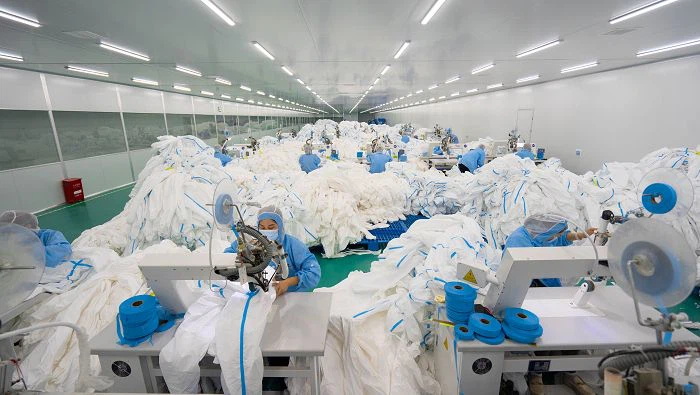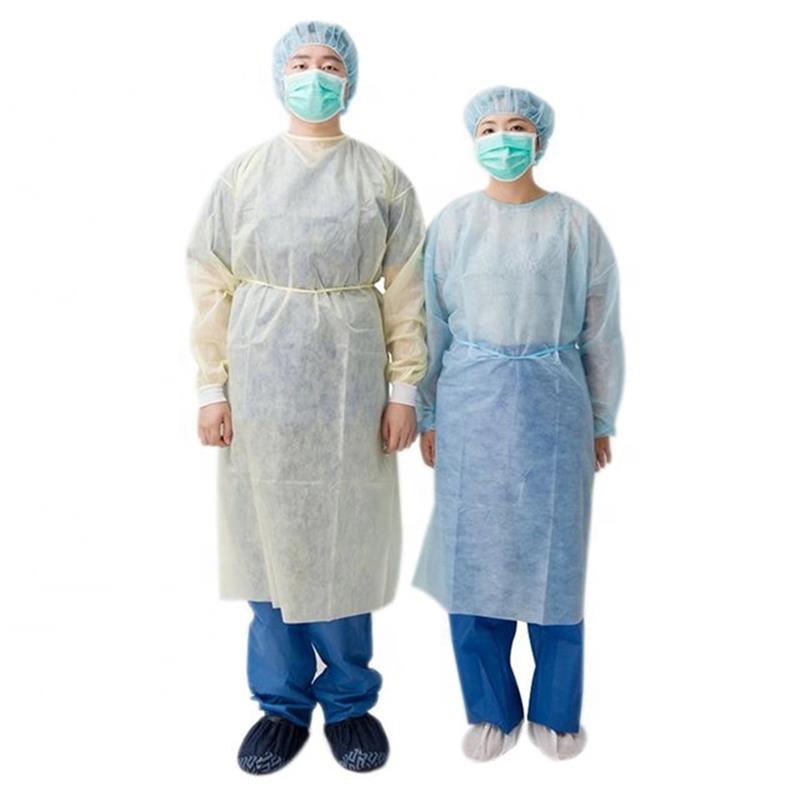Professional Isolation Gown Manufacturer & Supplier
JINYE is a leading manufacturer and supplier of high-quality Isolation Gowns with over 20 years of expertise in the PPE industry. Our commitment to safety is reflected in our extensive range of products, including surgical gowns, protective suits, masks, shoe covers, and disposable gloves. With a wealth of experience and professional knowledge, we prioritize quality and customization to meet your specific needs.

Product Overview:
Disposable Non Woven Isolation Gown
Material: PP+PE or SMS
Weight: 20-50g
Size: S/M/L/XL/XXL
Color: Blue, green, yellow or customized
Function: Block Harmful Splashes, Avoid Cross Infection
Application: Hospitals, medical installations, engineering, medicinal uses, etc



Isolation gowns are essential personal protective equipment used in various healthcare and industrial settings. Designed to provide a barrier against contaminants, these gowns are widely utilized in hospitals, clinics, laboratories, and cleanrooms.
They offer reliable protection for healthcare professionals during medical procedures, safeguarding against the transmission of infectious diseases. In industrial environments, isolation gowns shield workers from hazardous substances and ensure workplace safety.


Get Solution
Features Of Disposable Isolation Gown
Isolation gowns are protective equipment used to protect medical personnel from being infected by blood, body fluids and other infectious substances, or to protect patients from infection.

At JINYE, our disposable isolation gowns combine functionality with comfort, providing an effective solution for your protective needs.
Full Body Coverage: Provides comprehensive coverage from neck to knee, ensuring protection against contaminants.
Elastic Cuffs: Securely sealed cuffs prevent slipping, enhancing protection around wrists and arms.
Tie-Back Closure: Easy-to-tie back closure ensures a secure fit, allowing wearers to adjust according to their size.
Breathable Design: Offers breathability and comfort, reducing heat buildup during extended use.
Water-Resistant: Resistant to fluid penetration, safeguarding wearers from accidental splashes and spills.
Disposable and Eco-Friendly: Designed for one-time use, promoting hygiene and easy disposal, reducing environmental impact.
Versatile Usage: Suitable for various industries, including healthcare, laboratories, and industrial applications.
Compliance: Manufactured in compliance with industry standards and regulations, ensuring reliability and safety.
Cost-Effective: Affordable yet high-quality option, making it accessible for various facilities and applications.
Why Choose JINYE Isolation Gown
Premium Quality: Our isolation gowns are made from top-grade materials, meeting medical standards for safety and durability.
Disposable Design: Ensures one-time use, eliminating the risk of cross-contamination.
Comfortable Fit: Thoughtfully designed for comfort, allowing ease of movement without compromising protection.
Secure Closure: Reliable closures provide a snug fit, ensuring complete coverage during medical procedures.
Versatile Usage: Ideal for hospitals, clinics, laboratories, and various medical settings where safety is paramount.
Our Commitment to Safety
We prioritize your safety and that of your patients. Our disposable medical isolation gowns are meticulously tested to meet international standards. Whether you’re a healthcare professional or a patient, you can trust our gowns to provide the necessary protection.

How Isolation Gowns Contribute to Healthcare Worker Safety
Barrier Protection: Isolation gowns act as a crucial barrier between healthcare workers and infectious agents, preventing direct contact and minimizing the risk of contamination.
Infection Prevention: By wearing isolation gowns, healthcare workers reduce the transmission of pathogens, ensuring a safer environment for both medical staff and patients.
Splash and Fluid Resistance: Gowns with fluid-resistant properties shield healthcare workers from blood, bodily fluids, and other hazardous materials, preventing exposure and contamination.
Full Body Coverage: Isolation gowns provide comprehensive coverage, safeguarding not only the torso but also the arms and legs. This full-body protection is essential in preventing cross-contamination.
Comfort and Mobility: Modern isolation gowns are designed for comfort, allowing healthcare workers to perform tasks efficiently. They offer ease of movement, ensuring medical staff can carry out their duties without hindrance.
Compliance with Standards: High-quality isolation gowns adhere to safety standards, ensuring they meet the necessary requirements for protection. Compliance guarantees reliability and effectiveness.
Disposable Nature: Being disposable, these gowns can be discarded after use, eliminating the risk of spreading infections associated with reusable garments. This disposability ensures a fresh gown for each patient interaction.



Specialized Gowns: Apart from the standard levels, there are specialized isolation gowns designed for specific situations, such as chemotherapy-rated gowns for handling hazardous drugs or antistatic gowns for environments sensitive to static electricity.
Material Choices: Disposable Isolation gowns come in various materials, including polypropylene, SMS (spunbond-meltblown-spunbond), and PE (polyethylene). Each material has its unique protective properties, making it suitable for specific applications and protection levels.
Seam Types: The way gowns are stitched influences their protective integrity. Some gowns have taped seams for added fluid resistance and durability, ensuring that there are no weak points where fluids could penetrate.
Closure Styles: Gowns can have different closure styles, such as ties or tapes, which affect the gown’s fit and coverage. Proper closure ensures a secure and protective fit, reducing the risk of exposure.
Comfort and Breathability: Higher-end gowns prioritize comfort and breathability for healthcare workers. Enhanced comfort features, such as breathable fabrics and ergonomic designs, contribute to the overall satisfaction and usability of the gown.
Regulatory Compliance: It’s essential to choose gowns that meet relevant regulatory standards, ensuring they provide the specified level of protection. Compliance with standards guarantees the effectiveness and reliability of the gown in real-world applications.
Different Levels of Protection in Isolation Gowns
Level 1 Gowns: These isolation gowns offer basic protection against minimal risks. They are suitable for basic care tasks, such as standard isolation and basic patient care, where there is a low risk of exposure to fluids.
Level 2 Gowns: Providing a slightly higher level of protection, these isolation gowns are ideal for low to moderate-risk situations. They are commonly used in procedures involving a light to moderate amount of fluid exposure.
Level 3 Gowns: Offering a moderate to high level of protection, these isolation gowns are designed for moderate to heavy fluid exposure risks. They are often used in surgical settings or procedures where there is a significant risk of exposure to blood or bodily fluids.
Level 4 Gowns: These isolation gowns provide the highest level of protection and are reserved for high-risk situations. They are typically used in highly infectious environments, such as during major surgery or in situations where there is a high risk of exposure to infectious diseases.

How Isolation Gowns Are Tested for Quality Assurance


Material Inspection: Manufacturers inspect the raw materials (such as polypropylene, SMS, or PE) to ensure they meet the required specifications. The material’s strength, durability, and fluid resistance are assessed.
Tensile Strength Testing: Isolation gown materials undergo tensile strength tests to evaluate their ability to withstand stretching forces. This test ensures the material won’t tear easily during use.
Fluid Resistance Testing: Gowns are subjected to fluid resistance tests to determine their ability to repel liquids. The gown’s resistance to penetration by synthetic blood or other fluids is crucial, especially in high-risk environments.
Microbial Penetration Testing: Microbial penetration tests assess the gown’s ability to prevent the penetration of microorganisms. This test ensures that the gown provides an effective barrier against bacteria and viruses.
Seam Strength Testing: The strength of seams and closures is tested to ensure they won’t break or tear during use. Properly sealed seams are essential for maintaining the gown’s integrity.
Flame Resistance Testing: Some gowns undergo flame resistance testing, especially those used in specific environments where there is a risk of exposure to flames. Flame-resistant gowns are crucial in certain medical procedures.
Electrostatic Discharge (ESD) Testing: Certain gowns designed for environments sensitive to static electricity undergo ESD testing. These gowns prevent the buildup of static electricity, which could damage sensitive equipment.
Breathability Testing: Gowns are tested for breathability to ensure that healthcare workers can wear them comfortably for extended periods. Adequate air permeability is essential for user comfort.
Biocompatibility Testing: Gown materials are tested for biocompatibility to ensure they don’t cause adverse reactions when in contact with the skin. This is particularly important for gowns worn directly on the body.
Regulatory Compliance: Gowns are tested to comply with relevant standards and regulations, such as those set by the FDA (Food and Drug Administration) in the United States or the CE (Conformité Européene) marking in Europe. Compliance ensures that gowns meet industry standards for safety and performance.
Common Questions
Most Popular Questions.
Frequently Asked Questions (FAQ) about disposable isolation gowns
Isolation gowns are specifically designed to provide a higher level of protection against contaminants compared to regular gowns.
Disposable isolation gowns are often made from materials like polypropylene, SMS (spunbond-meltblown-spunbond), or PE (polyethylene).
Yes, certain isolation gowns meet surgical gown standards and can be used in surgical environments.
Yes, many medical isolation gowns have fluid-resistant properties to prevent liquids from penetrating the gown.
Used isolation gowns should be disposed of in designated medical waste bins following healthcare facility guidelines.
Yes, isolation gowns come in various sizes to accommodate different body shapes and sizes.
Yes, properly worn and used isolation gowns can provide a barrier against viruses and other contaminants.
Yes, isolation gowns are also used in various non-medical settings where protection against contaminants is necessary.
Some isolation gowns are designed to be reusable, but they must be properly sanitized and meet industry standards for reuse.
Isolation gowns are typically part of a full set of personal protective equipment (PPE) and should be worn in conjunction with other necessary gear for comprehensive protection
Isolation Gown
We would love to hear from you.
Get in touch
Leave us a message
To Get The Latest Medical Consumables Solutions
